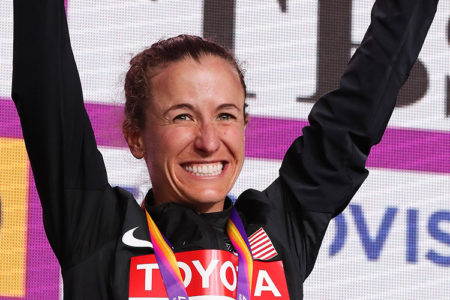
There it is on the cover of the May 1954 issue of Track & Field News.
An article titled “Bannister, His Day Of Days.” The long-anticipated cracking of miling’s 4:00 barrier was finally history and Roger Bannister’s name had become firmly etched in the annals of sport.
Here are selected highlights from that unbylined article as it ran in T&FN at the time, modified to reflect stylistic changes, and with some historical clarifications added:
<<Oxford, England, May 6—A pitifully small crowd of only 1200 waited in expectant silence for the results of the mile run in a dual meet between Oxford University and the British AAA team held on the Oxford track at Iffley Road.
”Ladies and gentlemen,” spoke the solemn voice of announcer Norris McWhirter [later to become famous as one of the founders of the Guinness Book Of World Records], “here is the result of event No. 9, the one-mile:
“1st, No. 41, R.G. Bannister, Amateur Athletic Association and formerly of Exeter and Merton Colleges, Oxford, with a time which is a new meeting and track record, and which, subject to ratification, will be a new English Native, British National, British All-Corner’s, European, British Empire, and World’s Record. The time was THREE…”
A roar from the spectators drowned further words. The 4:00 mile had been run.
The longest-awaited of all the coveted goals in track & field had been reached. The figures “3:59.4” and the name “Roger Bannister” flashed around the world, creating excitement and headlines everywhere…
Bannister, a 25-year-old, 6-1/150 medical student, did not decide to go all out until 15 minutes before the race began. Heavy rains earlier in the day and winds of about 15mph made a record run seem unlikely. In fact, competent observers said they think the magnificent race would have been 2 seconds faster under ideal conditions.
Six runners started in the race. Olympic steeplechaser Chris Brasher set the pace for the first two laps. After 220y, Bannister said, “Faster.”
At 2½ laps, with Brasher no longer able to push the pace, Bannister said, “Chris,” calling on former Oxford teammate and Olympic 5000m sensation Chris Chataway to take the pace.
Chataway increased the pace, which had slowed dangerously, and actually led Bannister with 300y to go. There, the long-striding Briton launched into his famous sprint, giving it everything he had in an all-out effort which contorted his usually pleasant face and left him completely exhausted at the tape…
Bannister’s pace: 28.7, 28.8 (57.5), 30.0 (1:27.5), 30.7/60.7 (1:58.2), 31.4 (2:29.6), 30.9/62.3 (3:00.5), 30.0 (3:30.5), 28.9/58.9…
Bannister’s time takes two full seconds off Gunder Hägg’s World Record. No man has ever lowered the mile record by a greater margin since the IAAF started keeping records…

It was a great comeback for Bannister, long recognized by insiders as a super runner but who sorely disappointed Britons when he “failed” in the ’52 Olympics.
At that time he had run three-quarters of a mile in practice in 2:52.9, but had not exposed himself to enough competition to cope with the greatest field of milers ever assembled.
His best miles, like this one, have been semiprivate affairs. He ran 4:03.6 on this same track last May, and 4:02.0 in London, June 27. The latter time, bettered only by Hägg and [Arne] Andersson until today, was not accepted by the British AAA because it was a paced race…
Bannister, who trained himself for years up to this year when he had some help from Austrian coach Franz Stampfl, prepared diligently for this record assault. All winter long he prepared, and for 3 weeks before the race he punished himself in practice.>>
The World Reacts
Reactions of interested persons throughout the world showed few of them surprised:
Wes Santee [an American who was a leading candidate to become the first sub-4:00 runner]: “Of the milers capable of doing it, Bannister is the one I’d just as soon have seen break it. The time still is not as low as it can be run.”
John Landy: “Santee will be next, but not I.” [Bad prediction: some 6 weeks later the Aussie not only broke 4:00, he also crushed Bannister’s WR with his 3:57.9.]
Hägg [whose 4:01.4 had stood as the WR for 9 years]: “Bannister has brains. He doesn’t overtrain the way many runners do.”…
Cordner Nelson [T&FN Founding Editor]: “It’s no surprise. I thought enough of Bannister to pick him to win in the Olympics, and two months ago I named him as one of three men having the best chance to run under 4:00. I still think Landy and Santee can do it, too.” [Santee was suspended by the AAU on a professionalism charge in ’55 and never did break 4:00.]
Brutus Hamilton [longtime Cal coach whose famous list of “ultimates” in ’34 had projected 4:01.0 for the mile]: “I’m glad Roger did it. The lad is a real amateur. He runs only because he loves to run… And I’m happy the record was made in a regular meet and not an exhibition. There’s more glory this way.”
Payton Jordan [Oxy coach and Stanford coach-to-be]: “I think Santee can go out and break it right now, and now that the barrier is broken, it’s only a matter of time until they get the record down to 3:55. I’ve always believed that’s where the record should be.”…
After the race Bannister suggested that his next goal would be 3:56, but added, “I don’t think I shall run against the watch again this year.”>>
[On August 7, in Vancouver, Bannister and Landy hooked up in “The Miracle Mile” at the Commonwealth Games, with Bannister winning 3:58.8–3:59.6 in the first race ever with two sub-4:00s. He never broke the barrier again.]





